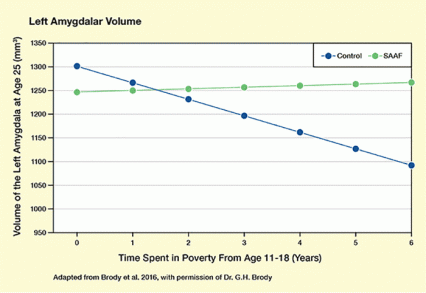This study found that:
- Childhood poverty was associated with reduced volumes of limbic brain regions in adulthood.
- The reduced limbic volumes were associated with depression and smoking in adulthood.
- Participation in Strong African American Families, a parenting-focused drug use prevention program, ameliorated those associations.
Children who grow up in poverty are vulnerable to a variety of health problems that often begin early in life and can persist across the life course. Childhood poverty’s ill effects can include deficits in the development of brain structures in the limbic system, including the hippocampus and amygdala. These structures contribute to learning, memory, mood, and responses to stress, and thus are crucial for academic functioning and social development. They have been implicated in addiction and other psychiatric disorders.
Dr. Gene H. Brody and colleagues at the Center for Family Research at the University of Georgia developed the parenting-focused Strong African American Families (SAAF) program with the aim of reducing the negative effects of poverty-associated life stresses on rural African American youths. Studies have demonstrated that SAAF improves participants’ self-control and reduces their propensity for drug use and conduct problems. Now, a new study suggests that SAAF can ameliorate poverty’s negative effects on limbic brain development.
Dr. Brody and colleagues used magnetic resonance imaging (MRI) to measure the volumes of the amygdala and hippocampus in two groups of 25-year-olds who had participated in a study of SAAF when they were 11 years old. One group had participated with their families in SAAF, while the others were assigned to a comparison group that was not exposed to SAAF. In addition to imaging the brain, the researchers also collected the 25-year-olds’ self-reports of levels of depression, cigarette smoking, and alcohol use, and used these data to assess potential correlations between psychosocial outcomes and limbic region volumes.
The brain images disclosed that, among the 25-year-olds whose families had not participated in SAAF, the left amygdala and left hippocampus were smaller in proportion to how much of their adolescence between ages 11 and 18 had been spent in poverty (see Figure). In contrast, among those who had participated in SAAF, the volumes of the limbic structures were relatively constant regardless of how much of their adolescence was spent in poverty. Across both groups, lower left hippocampal volumes correlated with higher levels of self-reported depression, and lower left amygdalar volumes were linked to increased cigarette smoking. No association was found between limbic-structure volumes and greater alcohol use.
Dr. Brody summarizes, “The study provides initial evidence suggesting that a family-oriented prevention program can reduce the effects of poverty on brain development. Fourteen years later, the youths who had participated in SAAF had larger hippocampal and amygdalar volumes than youths in the comparison group, despite having spent as many or more years in poverty.” These results are consistent with previous studies which have indicated that supportive parenting, a major focus of SAAF, might offset poverty-related risks to brain development. The results are particularly exciting because the SAAF program that appears to have achieved these long-lasting benefits consists of just seven 2-hour sessions. However, as the investigators noted, additional research will be required to substantiate the new findings.
The study was supported by NIH grant DA027827.
- Text Description of Figure
-
The figure plots the volume of the left amygdala in study participants at age 25 against the time spent in poverty during their youth (ages 11–18). The horizontal (x) axis shows the years spent in poverty from 0 to 6, and the vertical (y) axis shows the volume of the left amygdala in mm3, from 950 mm3 to 1350 mm3. The green curve represents participants who had participated in the Strong African American Families (SAAF) program and the blue curve represents the control group who had not participated in the program. In the control group, the volume of the left amygdala declined with longer time spent in poverty, from 1300 mm3 with no time spent in poverty to about 1270 mm3 with 1 year, 1230 mm3 with 2 years, 1200 mm3 with 3 years, 1160 mm3 with 4 years, 1125 mm3 with 5 years, and 1090 mm3 with 6 years spent in poverty. In the SAAF group, in contrast, the volume of the left amygdala remained stable or increased slightly, from 1250 mm3 with no time spent in poverty to about 1270 mm3 with 6 years spent in poverty.
Source:
- Brody, G.H., Gray, J.C., Yu, T., et al. Protective prevention effects on the association of poverty with brain development. JAMA Pediatr 171(1):46-52, 2017.
